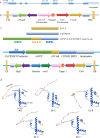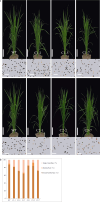Generation and characterization of rice OsCENH3 mutants for haploid induction
- PMID: 40760060
- PMCID: PMC12321917
- DOI: 10.1007/s00299-025-03581-z
Generation and characterization of rice OsCENH3 mutants for haploid induction
Abstract
CRISPR/Cas9-mediated modification of OsCENH3 induces aneuploidy but fails to trigger haploid formation in rice, underscoring limited efficiency and the need for strategy refinement. The centromeric histone H3 variant (CENH3) is essential for kinetochore assembly and accurate chromosome segregation during cell division. Alterations in CENH3 have been shown to trigger haploid induction in various plant species; however, its utility in rice remains largely unexplored. In this study, six OsCENH3 mutant lines were generated through CRISPR/Cas9-mediated genome editing, complemented by a GFP-tagged construct. To assess their haploid induction potential, both self pollination and outcrossing with the cultivar Nipponbare (NIP) were performed. Flow cytometry analysis revealed that none of the mutants produced true haploids. However, two aneuploid individuals (Het-C1-1-1 and Het-C1-5-1) were identified among the hybrid progeny derived from tail domain mutants C1-1 and C1-5, suggesting partial chromosome missegregation. These aneuploid plants exhibited reduced pollen viability, abnormal morphology, and compromised agronomic performance. In addition, significantly elevated rates of embryo/endosperm abortion were observed across different crosses, which far exceeded the frequency of aneuploid production, implying that early-stage chromosomal instability may result in embryo lethality. Collectively, while specific OsCENH3 mutations can induce limited chromosomal instability, their haploid induction efficiency remains low in rice. Further refinement of editing strategies and exploration of favorable genetic backgrounds will be essential for developing effective centromere-based haploid induction systems. This study provides a theoretical framework and technical reference for engineering haploid inducers in rice through centromere manipulation.
Keywords: Aneuploidy; CENH3; CRISPR/Cas9; Haploid induction; Rice.
© 2025. The Author(s).
Conflict of interest statement
Declarations. Conflict of interest: The authors declare that they have no competing interests.
Figures




Similar articles
-
Direct haploid formation in Arabidopsis using transgenic CENH3-based inducers.Plant Cell Rep. 2025 Jul 28;44(8):182. doi: 10.1007/s00299-025-03575-x. Plant Cell Rep. 2025. PMID: 40719891
-
Prescription of Controlled Substances: Benefits and Risks.2025 Jul 6. In: StatPearls [Internet]. Treasure Island (FL): StatPearls Publishing; 2025 Jan–. 2025 Jul 6. In: StatPearls [Internet]. Treasure Island (FL): StatPearls Publishing; 2025 Jan–. PMID: 30726003 Free Books & Documents.
-
Revolutionizing molecular plant breeding through genetic engineering of in vivo haploid induction genes.Mol Biol Rep. 2025 Aug 4;52(1):791. doi: 10.1007/s11033-025-10910-8. Mol Biol Rep. 2025. PMID: 40760280 Review.
-
Functional divergence and characterization of the HOTHEAD gene family in rice.BMC Genomics. 2025 Jul 30;26(1):703. doi: 10.1186/s12864-025-11901-6. BMC Genomics. 2025. PMID: 40739481 Free PMC article.
-
The Black Book of Psychotropic Dosing and Monitoring.Psychopharmacol Bull. 2024 Jul 8;54(3):8-59. Psychopharmacol Bull. 2024. PMID: 38993656 Free PMC article. Review.
References
-
- Cai M, Wei J, Li X, Xu C, Wang S (2007) A rice promoter containing both novel positive and negative cis-elements for regulation of green tissue-specific gene expression in transgenic plants. Plant Biotechnol J 5:664–674. 10.1111/j.1467-7652.2007.00271.x - PubMed
-
- Dong X, Xu X, Miao J, Li L, Zhang D, Mi X, Liu C, Tian X, Melchinger AE, Chen S (2013) Fine mapping of qhir1 influencing in vivo haploid induction in maize. Theor Appl Genet 126:1713–1720. 10.1007/s00122-013-2086-9 - PubMed
-
- Feng C, Yuan J, Bai H, Liu Y, Su H, Liu Y, Shi L, Gao Z, Birchler JA, Han F (2020) The deposition of CENH3 in maize is stringently regulated. Plant J 102:6–17. 10.1111/tpj.14606 - PubMed
MeSH terms
Substances
Grants and funding
LinkOut - more resources
Full Text Sources

